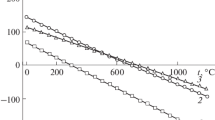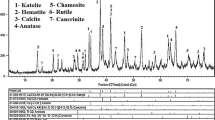The paper presents the results of studying the iron grain growth mechanism during carbothermal solidphase reduction of red mud in the presence of sodium sulfate. It was shown that the main mechanism of iron grain growth involves the formation of low-melting-point surface-active iron-sulfur compounds along the grain boundaries, which significantly accelerates their agglomeration process. The obtained results confirm a positive effect of the sodium sulfate additives on the process of iron grain growth during solid-phase carbothermal reduction of red mud, which makes it possible to improve the efficiency of subsequent magnetic separation.







Similar content being viewed by others
Change history
19 March 2020
The title of the article should read
19 March 2020
The title of the article should read
01 March 2020
A Correction to this paper has been published: https://doi.org/10.1007/s11015-020-00958-1
References
I. Oshurkova, “Bet on red,” in: Rossiyskaya Gazeta – Ekonomika URFO, No. 9 (7472) January 17 (2018), [Electronic Resource] URL: https://rg.ru/2018/01/17/reg-urfo/kitajcy-postroiatna-urale-zavod-po-pererabotke-opasnyh-othodov.html (access date: 07.18.2019).
D. V. Zinoveev, P. I. Grudinskii, L. V. Kovalenko, et al., “Review of global practices of red mud processing, Part 1. Pyrometallurgical methods,” Izv. Vuzov, Chern. Metallurg., 61, 11, 843–858 (2018).
R. K. Paramguru, P. C. Rath, and V. N. Misra, “Trends in red mud utilization – a review,” Mineral Processing and Extractive Metallurgy Rev., 26, 1, 1–29 (2004).
M. A. Khairul, J. Zanganeh, and B. Moghtaderi, “The composition, recycling and utilization of Bayer red mud,” Resources, Conservation & Recycling, 141, 483–498 (2019).
A. Anton, M. Rekasi, N. Uzinger, et al., “Modelling the potential effects of the Hungarian red mud disaster on soil properties,” Water, Air, & Soil Pollution, 223, 5175–5188 (2012).
N. A. Raspopov, V. P. Korneev, V. V. Averin, et al., “Reduction of iron oxides during the pyrometallurgical processing of red mud,” Russian Metallurgy (Metally), 1, 33–37 (2013).
E. Balomnenos, D. Kastritis, D. Panias, et al., “The enexal bauxite residue treatment process: industrial scale pilot plant results,” in: Light Metals, John Wiley & Sons, Inc., Hoboken, New Jersey, USA (2014), pp. 143-147.
Y. Yang, X. W. Wang, M. G. Wang, et al., “Recovery of iron from red mud by selective leach with oxalic acid,” Hydrometallurgy, 157, 239–245 (2015).
M. Fofana, S. Kmet, S. Yakabsky, et al., “Treatment of red mud from alumina production by high-intensity magnetic separation,” Magnetic and Electrical Separation, 6, 243–251 (1995).
Y. Liu, B. Zhao, and T. Yang, “Recycling of iron from red mud by magnetic separation after co-roasting with pyrite,” Thermochimica Acta, 588, 11–15 (2014).
C. Cardenia, E. Balomenos, and D. Panias, “Iron recovery from bauxite residue through reductive roasting and wet magnetic separation,” J. of Sustainable Metallurgy, 5(1), 9–19 (2019)
T. J. Chun, D. Q. Zhu, J. Pan, et al., “Preparation of metallic iron powder from red mud by sodium salt roasting and magnetic separation,” Can. Metallurgical Quarterly, 53, 2, 183–189 (2014).
D. Q. Zhu, T. J. Chun, J. Pan, et al., “Recovery of iron from high-iron red mud by reduction roasting with adding sodium salt,” J. of Iron and Steel Research Int., 19, 1–5 (2012).
G. H. Li, M. X. Liu, and M. J. Rao, “Stepwise extraction of valuable components from red mud based on reductive roasting with sodium salts,” J. of Hazardous Materials,280, 774–780 (2014).
G. S. Podgorodetskii, V. B. Gorbachev, V. V. Korovushkin, et al., “Study of the red mud structure currently produced by the Ural Aluminum Plant after thermal treatment in reducing gaseous medium,” Izv. Vuzov, Chern. Metallurg., No. 5, 8–14 (2012).
Ye. V. Shiryaeva, G. S. Podgorodetskii, T. Ya. Malysheva, et al., “Effect of low-alkaline red mud on the properties and microstructure of the furnace charge agglomerate of JSC “Uralskaya Stal,” Izv. Vuzov, Chern. Metallurg., No. 1, 14–19 (2014).
A. Roine, HSC Chemistry 9.9®[Software], Pori: Outotec (2019), [Electronic resource], URL: www.outotec.com/HSC.
P. I. Grudinskii, V. G. Dyubanov, D. V. Zinoveev, et al., “Solid-phase reduction and iron grain growth in red mud in the presence of alkali metal salts,” Russian Metallurgy (Metally), No. 11, 1020–1026 (2018).
Z. G. Liu, T. C. Sun, X. P. Wang, et al., “Generation process of FeS and its inhibition mechanism on iron mineral reduction in selective direct reduction of laterite nickel ore,” Int. J. of Minerals, Metallurgy, and Materials, 22, 9, 901–906 (2015).
M. Jiang, T. C. Sun, Z. G. Liu, et al., “Mechanism of sodium sulfate in promoting selective reduction of nickel laterite ore during reduction roasting process,” Int. J. of Mineral Processing, 123, 32–38 (2013).
P. Walder and A.D. Pelton, “Thermodynamic modeling of the Fe–S system,” J. of Phase Equilibria and Diffusion, 26, 1, 23–28 (2005).
E. X. Gao, T. C. Sun, Z. G. Liu, et al., “Effect of sodium sulfate on direct reduction of beach titanomagnetite for separation of iron and titanium,” J. of Iron and Steel Research Int.,23, 5, 428–433 (2016).
G. H. Li, T. M. Shi, M. J. Pao, et al., “Beneficiation of nickeliferous laterite by reduction roasting in the presence of sodium sulfate,” Minerals Engineering, 32, 19–26 (2012).
O. Kubaschewski, C. Alcock, and P. J. Spencer, Materials Thermochemistry, Pergamon Press, Oxford, U.K. (1993).
The study was carried out with the financial support of The Russian Foundation for Basic Research (RFFI) within the scope of the research project No. 18-29-24186.
Author information
Authors and Affiliations
Corresponding author
Additional information
Translated from Metallurg, Vol. 63, No. 9, pp. 15–21, September, 2019. Original article submitted May 15, 2019.
Rights and permissions
About this article
Cite this article
Grudinskii, P.I., Zinoveev, D.V., Semenov, A.F. et al. Advanced Method for Recycling Red Mud by Carbothermal Solid-Phase Reduction Using Sodium Sulfite. Metallurgist 63, 889–897 (2020). https://doi.org/10.1007/s11015-020-00906-z
Received:
Published:
Issue Date:
DOI: https://doi.org/10.1007/s11015-020-00906-z




